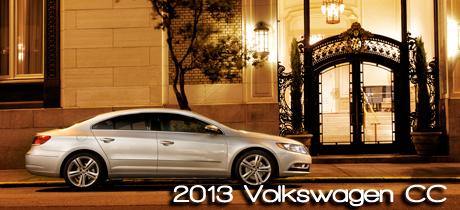
2013 Volkswagen CC Road Test Review
By Bob Plunkett
Luxury Car Buyer's Guide - RTM's Top 8 Picks for 2013 |
|
We're whipping along the two-lane Empire Grade that slithers down slopes of California's Coastal Range to Santa Cruz on the Pacific Ocean in a test car with dramatic package styling and power to spare: It's the Volkswagen's 2013 CC.
The CC slots into the mid-size class in configuration with a 5-seat cockpit and four doors for passengers plus a tail-side trunk bin.
With its low roofline and integrated rear doors, the CC looks sleek like a curve-craving coupe that slinks snug against asphalt, yet it provides a pair of doors on each side like a family-friendly sedan with two rows of seats in the posh cabin and easy entry/exit for every passenger.
It's as if designers for the German automaker Volkswagen tossed a coupe and sedan into a gigantic car blender and mixed ingredients until the sleek CC emerged.
VW laces the CC with serious mechanical hardware which includes a strong engine (with options for a turbo four-pack or zipper V6), and electronics governing the vehicle's dynamic movements as well as communications, navigation, comfort, even on-board entertainment gear.
But a forceful engine and extensive content in electronic vehicle controls are not what causes our 2013 CC to stand out when parked on a promontory overlooking Pacific blue waters on the California coast at Santa Cruz: It's the gorgeous design of the sheetmetal that makes the CC so much automotive eye candy.
Theme for the exterior is a fluidity of lines drawn in rectangular format but capped by an arching canopy over the cabin with frameless doors and low-slung windows plus side pillars muted to create the impression of a swift coupe.
Still, you can't miss the bold design of that brash face sporting a new three-blade grille tied to corner bi-xenon headlamps to forge a single horizontal unit stacked above a smooth wrap of body-colored fascia. Below the fascia is a broad air intake and foglights housed inside winglets pinned at the ends.
CC's designers added LED daytime running lights and AFS (Adaptive Front-lighting System), which swivels headlamp beams up to 15 degrees around corners to enhance visibility for the CC driver.
Side panels are chiseled with ripples and a character line notched on each shoulder seems to swing upward in swift movement toward the tail, while sills gain sculpted lines.
The blunted rump looks clean with new LED taillamp assemblies wrapping around corners and a deeper swoopy body-colored bumper with dual exhaust pipes tucked underneath.
Pop the rear deck and you'll find a trunk compartment with 13.2 cubic feet of storage space.
Now open any door and slip into a supportive seat that fits like a custom-built lounge chair.
Cabin layout is familiar with two sport buckets in front and a new three-place bench on the second row. The rear bench splits and folds to increase cargo capacity, and there's a center pass-through portal to the trunk as well.
CC's wheelbase -- almost nine feet long -- provides sufficient legroom for riders in rear quarters.
Driver's heated bucket seat moves 12 different ways through power-motivated contortions to guarantee a comfortable position.
Seat upholstery ranges from high-quality leatherette or soft leather with trimwork in composite material or brushed aluminum metal.
Standard cabin equipment for all CC issues includes power controls for windows and door locks, air conditioning, remote releases for trunk and fuel doors, a tire pressure monitoring system and electronic parking brake, an adjustable steering wheel, Bluetooth connectivity and a premium audio system with AM/FM/6CD/MP3.
Volkswagen offers two powertrain choices for the 2013 CC, with model nomenclature describing engine displacement.
CC 2.0T editions carry VW's 2.0-liter four-cylinder turbo plant in FWD (front-wheel-drive) format with a twin-clutch and six-speed DSG (Direct Shift Gearbox) automated manual transmission or, for Sport and R-Line editions, a shift-it-yourself six-speed manual.
The four-in-line turbo plant produces 200 hp at 5100 rpm plus 207 lb-ft of torque at 1700 rpm.
VW also outfits the 2013 CC with a V6 engine and the six-speed DSG automatic under the badge of CC VR6.
It's fired by an aluminum narrow-angle V6 which displaces 3.6 liters and employs dual overhead cams. The V6 romps with 280 hp at 6200 rpm plus a flat torque line peaking to 265 lb-ft at 2750 rpm.
For CC VR6, Volkswagen adds the option of all-wheel-drive (AWD) traction through a mechanism dubbed 4Motion, which enhances wheel traction on pavement by continuously distributing the engine's power to all wheels. Operation of the 4Motion system is automatic.
CC for 2013 skews to six trim levels: 2.0T Sport, 2.0T Sport Plus, 2.0T R-Line, 2.0T Lux, VR6 Lux, VR6 4Motion Executive.
The sporty 2.0T R-Line edition, available early in 2013, adds 18-inch aluminum-alloy wheels, lower extended sport bumpers, R-Line door sill plates and darkened taillights. It configures with either the six-speed manual or dual-clutch DSG automatic transmission.
Volkswagen's price chart for the 2013 CC ranges from $30,610 for the CC 2.0T Sport with a manual transmission to $41,420 for CC VR6 4Motion Executive with the DSG automatic.
For more information on Volkswagen cars, click here
|